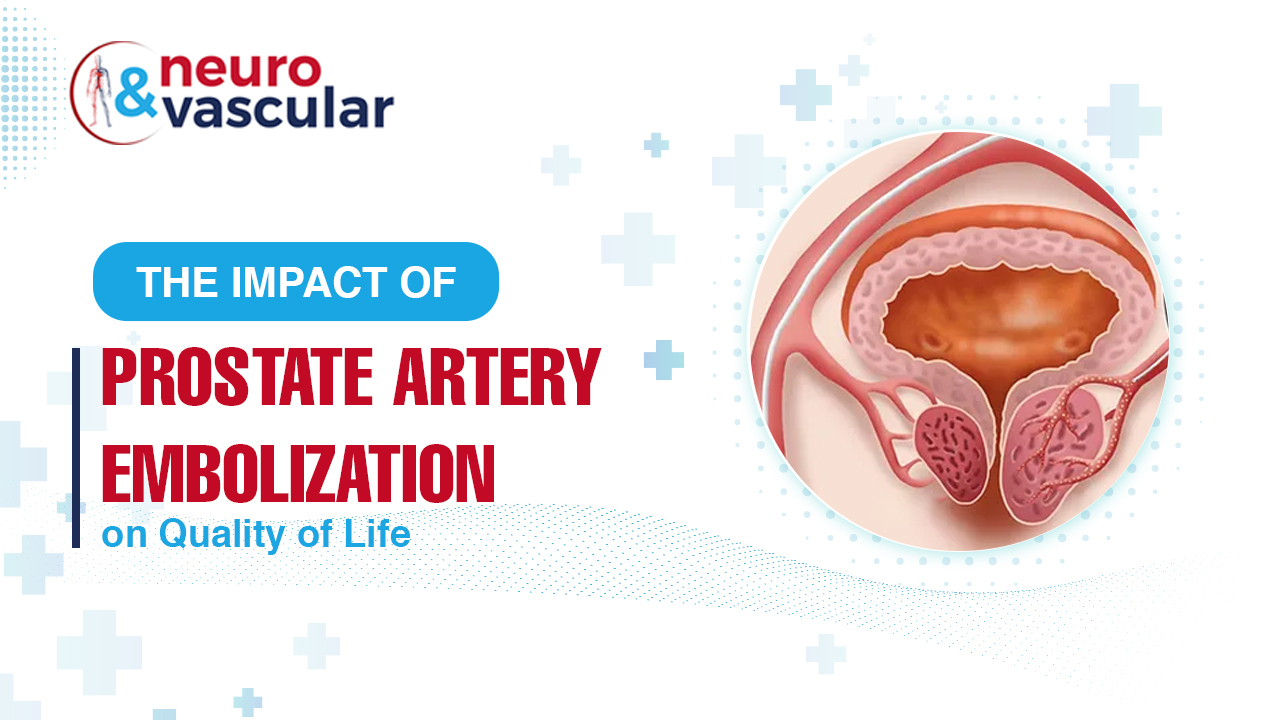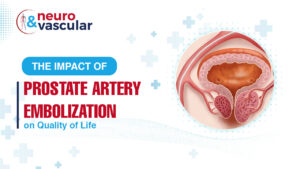
The Impact of Prostate Artery Embolization on Quality of Life

Prostate artery embolization (PAE) is a minimally invasive treatment for people suffering from lower urinary tract symptoms (LUTS) which are mainly caused by benign prostatic hyperplasia (BPH). PAE is a relatively new method for benign prostatic hyperplasia which is also called as prostate gland enlargement. PAE is an effective method which requires no cutting and offers fast recovery time with minimal pain. BPH is a prevalent problem in old age men over 50, with poor urine flow, frequent urination, and incomplete bladder emptying are some symptoms of noncancerous enlargement of the prostate gland.
How Does it Work?
Prostate artery embolization (PAE) is a promising solution for patients with an enlarged prostate or BPH. If you’re a man over 50, you may suffer from benign prostatic hyperplasia (BPH). This is a condition where the prostate gland enlarges, causing discomfort and showing other symptoms. Instead of surgery, interventional radiologist use vascular catheters to deliver small particles to the affected area, reducing blood flow and shrinking the prostate. The PAE procedure is personified as per the patient’s conditions to get back your life on track with PAE.
Revolutionary Prostate Artery Embolization Technique
A pioneering treatment involves using catheterization to access the arteries leading to the prostate gland. This innovative method starts by injecting a dye (arteriogram) through the catheter, mapping the blood vessels leading to the gland. The key to this innovative therapy is the injection of microscopic spheres, which reduce the blood supply to the gland. After the first side of the gland is treated, the other side receives the same treatment.
Must read: Advantages of Prostatic Artery Embolization for an Enlarged Prostate
How Prostate Artery Embolization impacts the quality of life?
Prostate Artery Embolization (PAE) is an effective and minimally-invasive treatment option for many men. It is a treatment for prostate conditions that offers many benefits. These are:
Relief of Urinary Symptoms:
PAE relieves men who suffer from urinary symptoms, such as frequency and urgency. These symptoms can affect the quality of life by causing discomfort and embarrassment. PAE reduces the prostate gland’s size, allowing urine to flow more freely. This results in improved urinary function and increased quality of life.
Avoidance of Invasive Treatment:
PAE is a minimally invasive procedure that does not require general anesthesia. Typically, patients go home the same day after the procedure under local anesthesia. Traditional treatment approaches, such as surgery, require hospitalization and the risk of complications. By avoiding invasive treatment, men can maintain their quality of life without risking their health.
Improvement in Sexual Function:
An enlarged prostate gland can also impact sexual function. PAE can improve sexual function by reducing the size of the prostate gland and urinary symptoms. This can lead to increased sexual activity, positively impacting the quality of life for men and their partners.
Rapid Recovery:
PAE has a short recovery period compared to traditional surgical approaches. The procedure takes only two hours. Patients typically experience mild discomfort and can return to normal activities within a few days. This rapid recovery allows men to resume their daily activities without interruption, which improves their quality of life.
Long-Term Results:
PAE has been shown to provide long-term relief for men with enlarged prostate glands. Studies have demonstrated that PAE’s benefits can last up to five years. It means that men can enjoy an improved quality of life for an extended period. This long-term relief enables men to maintain their independence and enjoy life without the impact of urinary symptoms.
Side Effects of Prostate Artery Embolization
Prostate Artery Embolization has proven highly effective and successful, but medical treatment can have a few risks. While rare, patients must consider potential side effects before undergoing the procedure. PAE presents some minor risks, such as:
- Bruising or bleeding at the groin.
- Mild discomfort can be felt in the lower abdomen and while going to the bathroom for up to ten days after the procedure. Though this typically resolves on its own with no long-term effects.
- Bacteria may enter your bloodstream through a catheter used during treatment; antibiotics will clear it up if this happens.
- The patient may also feel more tired than usual for around one week following PAE.
- Some patients may experience difficulty urinating temporarily afterwards, unlike TURP patients, who could suffer ongoing incontinence issues.
Conclusion
By using Prostatic artery embolization, you can switch to alternative treatment to traditional surgery. If you are experiencing any urinary symptoms due to BPH, then it might be time to visit our interventional specialist. Through Prostatic Artery Embolization (PAE), they can determine if this minimally-invasive procedure is the right solution for your needs or not. The PAE treatment positively impacts the quality of life of men. During the appointment, expect questions you may get. Share all the symptoms with your interventional radiologist specialist so that they can treat you accordingly.
FAQs
How successful is prostate artery embolization?
Prostate artery embolization procedures can significantly improve patients’ urinary symptoms and quality of life. It has a lower risk of complications and allows for a quicker recovery time.
How does prostate artery embolization affect the prostate?
Through prostate artery embolization the intricate arteries supplying blood to the prostate are blocked off. This causes the gland to shrink in size and promotes improved urine flow since it relieves pressure on the urethra.
What negative consequences can prostate artery embolization cause?
After prostate artery embolization, patients may experience some symptoms. These symptoms range from nausea and vomiting to pelvic pain or painful urination. Other possible hazards include bladder spasms, infections at the puncture site and prostate, and blood in the urine or stool.
About the Author:

Name: DR . SURESH GIRAGANI
INTERVENTIONAL RADIOLOGIST
DR. SURESH GIRAGANI CONSULTANT INTERVENTIONAL RADIOLOGIST at Apollo hospitals Jubilee Hills, has more than sixteen years of clinical experience in vascular interventions with a special interest in neurovascular and peripheral vascular disease interventional procedures.